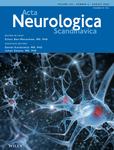Congenital myopathies in adults: A diagnosis not to overlook
Abstract
Background
Congenital myopathies (CM) were traditionally classified according to the muscle histopathological features, but in recent years, molecular diagnosis has become increasingly important. CM may present a wide phenotype variability, and while adult-onset CM have been increasingly recognized, substantial diagnostic delays are still reported.
Objectives
To describe a cohort of adult CM patients, including clinical, genetic, and histopathological features, and further characterize the subgroup of adult-diagnosed patients.
Materials and Methods
We performed a retrospective observational cohort study to characterize the CM patients evaluated in our adult Neuromuscular outpatient clinic, including the subgroup of adult-diagnosed patients.
Results
We identified 19 CM patients with compatible molecular and/or histological diagnoses, of which 14 were diagnosed in adulthood. Eleven adult-diagnosed patients had symptoms since childhood and 9 had a family history of myopathy. The median age of symptoms' onset was 4 years old and the median age at diagnosis was 37 years old. The most common causative gene was RYR1, followed by TTN and MYH7. Three patients had non-specific features on muscle biopsy, all diagnosed during adulthood.
Conclusions
In our cohort, the majority of CM were diagnosed in adulthood, despite most having pediatric-onset symptoms and positive family history. The diagnostic delay may be associated with mild presentation, slow course, atypical muscle histology, and lack of awareness of adult-onset CM. Studies with larger populations are needed.
CONFLICT OF INTEREST
The authors declare no potential conflicts of interest.
Open Research
DATA AVAILABILITY STATEMENT
The data that support the findings of this study are available on request from the corresponding author. The data are not publicly available due to privacy or ethical restrictions.




